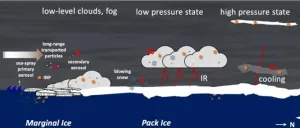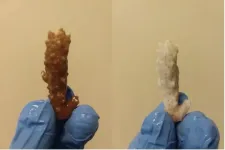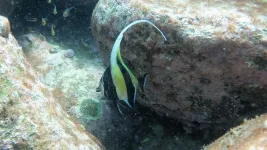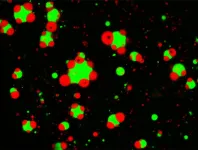Better understanding the reasons behind Arctic amplified warming
2021-02-08
(Press-News.org) It's clear that rising greenhouse gas emissions are the main driver of global warming. But on a regional level, several other factors are at play. That's especially true in the Arctic - a massive oceanic region around the North Pole which is warming two to three times faster than the rest of the planet. One consequence of the melting of the Arctic ice cap is a reduction in albedo, which is the capacity of surfaces to reflect a certain amount of solar radiation. Earth's bright surfaces like glaciers, snow and clouds have a high reflectivity. As snow and ice decrease, albedo decreases and more radiation is absorbed by the Earth, leading to a rise in near-surface temperature.
The other regional, yet much more complex factor that scientists need to pay detailed attention to relates to how clouds and aerosols interact. Aerosols are tiny particles suspended in the air; they come in a wide range of sizes and compositions and can occur naturally - such as from sea spray, marine microbial emissions or forest fires (like in Siberia) - or be produced by human activity, for exemple from the combustion of fossil fuels or agriculture. Without aerosols, clouds cannot form because they serve as the surface on which water molecules form droplets. Owing to this role, and more specifically to how they affect the amount of solar radiation that reaches the Earth surface, and the terrestrial radiation that leaves the Earth, aerosols are an essential element in regulating the climate and Arctic climate in particular.
"A lot of question marks"
In a paper published in Nature Climate Change on 8 February, Julia Schmale, the head of EPFL's Extreme Environments Research Laboratory, alerts the scientific community to the need for a better understanding of aerosol-related processes. "How albedo is affected by ice is fairly well understood - there are established maximum and minimum values, for example," says Schmale. "But when it comes to groups of aerosols, there are many variables to consider: will they reflect or absorb light, will they form a cloud, are they natural or anthropogenic, will they stay local or travel long distances, and so on. There are a lot of question marks out there, and we need to find the answers." She worked on the paper with two coauthors: Paul Zieger and Annica M. L. Ekman, both from the Bolin Centre for Climate Research at Stockholm University.
Schmale has carried out several research expeditions to the North Pole, most recently in early 2020 on the German icebreaker Polarstern. She saw first-hand that the Arctic climate tends to change fastest in the winter - despite there being no albedo during this period of 24-hour darkness. Scientists still don't know why. One reason could be that clouds present in winter are reflecting the Earth's heat back down to the ground; this occurs to varying degrees depending on natural cycles and the amount of aerosol in the air. That would lift temperatures above the Arctic ice mass, but the process is extremely complicated due to the wide range of aerosol types and differences in their capacity to reflect and absorb light. "Few observations have been made on this phenomenon because, in order to conduct research in the Arctic in the wintertime, you have to block off an icebreaker, scientists and research equipment for the entire season," says Schmale.
Improving weather models
Although many research expeditions have already been carried out in the Arctic, a lot remains to be explored. One option could be to collect all the discoveries made so far on Arctic warming and use them to improve existing weather models. "A major effort is needed right away, otherwise we'll always be one step behind in understanding what's going on. The observations we've already made could be used to improve our models. A wealth of information is available, but it hasn't been sorted through in the right way to establish links between the different processes. For instance, our models currently can't tell us what kinds of aerosols contribute the most to climate change, whether local or anthropogenic," says Schmale.
In their paper, the research team puts forth three steps that could be taken to gain better insight into the Arctic climate and the role played by aerosols. They suggest creating an interactive, open-source, virtual platform that compiles all Arctic knowledge to date. They point to the International Arctic Systems for Observing the Atmosphere (IASOA) program as an example; the IASOA coordinates the activities of individual Arctic observatories to provide a collaborative international network for Arctic atmospheric research and operations. "We need to improve our climate models because what's happening in the Arctic will eventually spread elsewhere. It's already affecting the climate in other parts of the northern hemisphere, as we've seen with the melting glaciers and rising sea levels in Greenland. And to develop better models, a better understanding of aerosols' role will be crucial. They have a major impact on the climate and on human health," says Schmale.
INFORMATION:
[Attachments] See images for this press release:

ELSE PRESS RELEASES FROM THIS DATE:
2021-02-08
What The Study Did: Researchers investigated the association between the use of proton pump inhibitors among children and adolescents in Sweden and the risk of asthma.
Authors: Yun-Han Wang, M.Sc., B.Pharm., of the Karolinska Institutet in Stockholm, is the corresponding author.
To access the embargoed study: Visit our For The Media website at this link https://media.jamanetwork.com/
(doi:10.1001/jamapediatrics.2020.5710)
Editor's Note: The article includes conflict of interest and funding/support disclosures. Please see the article for additional information, including other authors, author contributions and affiliations, conflict ...
2021-02-08
What The Article Says: In this essay, the authors describe a 97-year-old patient who learned to titrate condensed chicken soup like a medicine during the COVID-19 pandemic.
Authors: Yuenting Diana Kwong, M.D., M.A.S., University of California, San Francisco, is the corresponding author.
To access the embargoed study: Visit our For The Media website at this link https://media.jamanetwork.com/
(doi:10.1001/jamainternmed.2020.8897)
Editor's Note: The article includes conflicts of interest disclosures. Please see the article for additional information, including other authors, author contributions and affiliations, conflict of interest and financial disclosures, ...
2021-02-08
What The Study Did: Salary information from faculty at U.S. medical schools was used to examine the association between the percentage of female clinicians in a medical specialty and the average and median salaries for that specialty.
Authors: Terrill Bravender, M.D., M.P.H., of the University of Michigan in Ann Arbor, is the corresponding author.
To access the embargoed study: Visit our For The Media website at this link https://media.jamanetwork.com/
(doi:10.1001/jamapediatrics.2020.5683)
Editor's Note: The article includes conflict of interest disclosures. Please see the article for additional information, including other authors, author ...
2021-02-08
Coral reefs are beautiful and diverse ecosystems that power the economies of many coastal communities. They're also facing threats that are driving their decline, including the planet's warming waters.
This threat hit extreme levels in 2015, when high temperatures were turning corals white around the globe. Kaneohe Bay in Hawaii was hit hard; nearly half of its corals bleached.
Hidden in the aftermath of this extreme event, however, were biochemical clues as to why some corals bleached while others were resistant, information that could help reefs better weather warming waters in the future. These clues have now been uncovered by researchers at Michigan State University and the University of Hawaii at Manoa.
"It was kind of horrifying," said coral biologist Crawford Drury, who witnessed ...
2021-02-08
Researchers at the University of Massachusetts Amherst have gained new insight into the biological processes of a chytrid fungus responsible for a deadly skin infection devastating frog populations worldwide.
Led by cell biologist Lillian Fritz-Laylin, the team describes in a paper published Feb. 8 in Current Biology how the actin networks of Batrachochytrium dendrobatidis (Bd) also serve as an "evolutionary Rosetta Stone," revealing the loss of cytoskeletal complexity in the fungal kingdom.
"Fungi and animals seem so different, but they are actually pretty closely related," says Fritz-Laylin, whose lab studies how cells move, which is a central ...
2021-02-08
The findings are published in the prestigious journal, Nature Climate Change, and calls on businesses, the financial services industry and regulators to work more closely with climate scientists.
Regulators and governments - both domestic and international - are increasingly requiring that businesses assess and disclose their vulnerability to the physical effects of climate change, for example, increased drought, bushfires and sea level rise.
"People are making strategically material decisions on a daily basis, and raising debt or capital to finance these, but the decisions may not have properly considered climate risk," said lead author Dr Tanya Fiedler from the University of Sydney Business School. ...
2021-02-08
Under increasing global warming, tropical fish are escaping warmer seas by extending their habitat ranges towards more temperate waters.
But a new study from the University of Adelaide, published in Nature Climate Change, shows that the ocean acidification predicted under continuing high CO2 emissions may make cooler, temperate waters less welcoming.
"Every summer hundreds of tropical fish species extend their range to cooler and temperate regions as the waters of their natural habitat become a little too warm for comfort," says lead author Ericka Coni, PhD student in the University's School of Biological Sciences. "For at least two decades, Australian temperate reefs have been receiving new guests ...
2021-02-08
Recycling cans and bottles is a good practice. It helps keep the planet clean.
The same is true for recycling within cells in the body. Each cell has a way of cleaning out waste in order to regenerate newer, healthier cells. This "cell recycling" is called autophagy.
Targeting and changing this process has been linked to helping control or diminish certain cancers. Now, University of Cincinnati researchers have shown that completely halting this process in a very aggressive form of breast cancer may improve outcomes for patients one day.
These results are published in the Feb. 8 print edition of the journal Developmental Cell.
"Autophagy is sort of like cell cannibalism," ...
2021-02-08
BUFFALO, N.Y. -- In cells, numerous important biochemical functions take place within spherical chambers made from proteins and RNA.
These compartments are akin to specialized rooms inside a house, but their architecture is radically different: They don't have walls. Instead, they take the form of liquid droplets that don't have a membrane, forming spontaneously, similar to oil droplets in water. Sometimes, the droplets are found alone. Other times, one droplet can be found nested inside of another. And these varying assemblies can regulate the functions the droplets perform.
A study published on Feb. 8 in Nature Communications explores how these ...
2021-02-08
Some coronaviruses can add to their genetic pool some genes belonging to the host they infected. In this way, they can blend in and be less detectable to the immune system. This discovery was published in the journal Viruses by an Italian research team from the IIS (Italian Healthcare Institute), ISPRA (Institute for Environmental Protection and Research), IZSLER (Italian health authority and research organization for animal health and food safety of Lombardy and Emilia-Romagna) and the University of Bologna.
The outcome of this study demonstrates that coronaviruses encompass a sophisticated evolutionary mechanism ...
LAST 30 PRESS RELEASES:
[Press-News.org] Better understanding the reasons behind Arctic amplified warming





